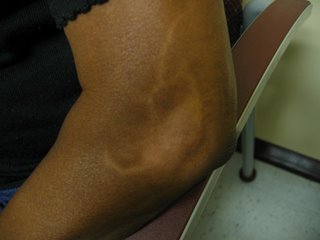Discoloration on the elbow

67 y, AA woman, h/o HTN, GERD and recurrent UTI presents to the office with skin discoloration over her Lt elbow that started about 5 weeks ago. She denies any discomfort or pruritus at the site. She does not have similar lesions anywhere else on the body. Her current meds include Enalapril, Aciphex, Valium, Vaginal estrogens and Ciprofloxacin.
Exam shows a 4-6 cm hypopigmented macule over the lt. elbow. Neurological exam was normal.
Which of the following statements is most appropriate?
1. This is a complication of treatment she received for tennis elbow 3 months ago.
2. She has pityriasis alba.
3. Tuberculoid leprosy should be considered as the most likely diagnosis.
4. This is a ash-leaflet hypopigmented macule suggestive of tuberous sclerosis
5. This is a new onset vitiligo, she might respond to topical steroids.



